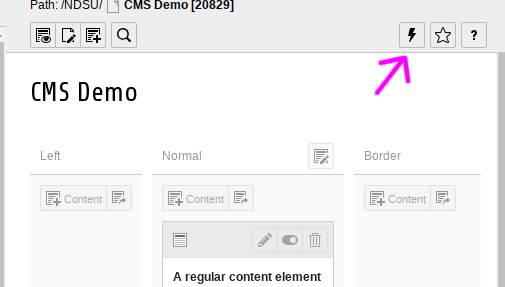How to clear page cache
- Using the Page module, select the page where you want to clear cache
- Click the "lightning bolt" icon at the top right

This will only clear the cache for the selected page, not any of its subpages.
Note: Your browser (Internet Explorer, Firefox, etc.) caches pages and files so that you don't need to re-download them every time you view the page or file. This means that if a page or linked file is updated, you may need to clear your browser cache to see the change. The simplest way to to re-download a single page is to hold the Shift key down while clicking the refresh/reload button in your browser. Wikipedia also writes about bypassing cache. All of the same principles in the introduction and Section 1 (including Section 1 sub-sections) of the Wikipedia article apply.
What is cache and how does CMS use it?
As defined at wikipedia.org on 2/15/08, cache is "a temporary storage area where frequently accessed data can be stored for rapid access."
CMS uses caching at a few levels. It may cache individual content elements or entire pages as they display in your browser. It caches many files, especially image files. It also caches URLs. It caches configurations used in the backend and the page template.
Why does it do all this?
To reduce the amount of time required to display a page in your Web browser. To display a page for the first time, CMS must
- Retrieve page template information from the database and files
- Assemble automatically-generated navigation, skipping any hidden or hidden-in-menu pages
- Retrieve reusable content, including footers and banner text
- Retrieve or calculate page information, including title and last-modified date
- Retrieve visible content elements, skipping any hidden content elements
- Resize images in content elements as necessary, saving the result as a reusable file
- Assemble content from plug-ins such as news
- Generate URL information (since CMS rewrites URLs from workspaces.ndsu.edu/index.php?id=8271 to a friendlier format like www.ndsu.edu/cms/faq/
Retrieving and processing this for every visitor that comes to your site would cause significant "load" on the server and cause delays to view pages. Saving the generated page in a cache means the page "snapshot" can be quickly retrieved for display to visitors.
This comes at the expense of occasionally requiring you to manually clear caches, forcing CMS to rebuild the page it displays to visitors. Generally, a manual cache clear is only required when a page name is changed or moved (since navigations for pages not directly affected will not be rebuilt) or if template parts, like footers, are updated.
CMS automatically clears its internal caches at midnight daily, which is why you may notice that, without manually clearing cache, some actions take "overnight" to be visible on your site.


